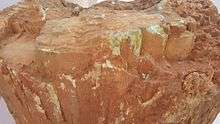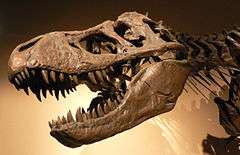Fossil wood


| Part of a series on |
| Paleontology |
|---|
 |
|
Organs and processes |
|
History of paleontology |
|
Branches of paleontology |
|
Paleontology Portal Category |
Fossil wood is wood that is preserved in the fossil record. Over time the wood will usually be the part of a plant that is best preserved (and most easily found). Fossil wood may or may not be petrified. The study of fossil wood is sometimes called palaeoxylology, with a "palaeoxylologist" somebody who studies fossil wood.
The fossil wood may be the only part of the plant that has been preserved, with the rest of the plant completely unknown:[1] therefore such wood may get a special kind of botanical name. This will usually include "xylon" and a term indicating its presumed affinity, such as Araucarioxylon (wood of Araucaria or some related genus), Palmoxylon (wood of an indeterminate palm), or Castanoxylon (wood of an indeterminate chinkapin).[2]
Types
Petrified wood
Petrified wood are fossils of wood that have turned to stone through the process of permineralization. All organic materials are replaced with minerals while maintaining the original structure of the wood.
The most notable example is the petrified forest in Arizona.[3]
Mummified wood
Mummified wood are fossils of wood that have not permineralized.[4] They are formed when trees are buried rapidly in dry cold or hot environments. They are valued in paleobotany because they retain original cells and tissues capable of being examined with the same techniques used with extant plants in dendrology.[5]
Notable examples include the mummified forests in Ellesmere Island[6] and Axel Heiberg Island.[7]
Submerged forests
Submerged forests are remains of trees submerged by marine transgression. They are important in determining sea level rise since the last glacial period.[8]
See also
References
- ↑ Ed Strauss (2001). "Petrified Wood from Western Washington". Retrieved April 8, 2011.
- ↑ Wilson Nichols Stewart; Gar W. Rothwell (1993). Paleobotany and the evolution of plants (2 ed.). Cambridge University Press. p. 31. ISBN 978-0-521-38294-6.
- ↑ "Petrified Forest National Park". National Park Service, US Department of the Interior. Retrieved April 8, 2011.
- ↑ Kelly Greig (January 17, 2011). "Mummified Forest Shows Effect of Changing Climate". Canadian Geographic. Retrieved April 8, 2011.
- ↑ Thomas N. Taylor; Edith L. Taylor; Michael Krings (2009). Paleobotany: the biology and evolution of fossil plants. Academic Press. p. 33. ISBN 978-0-12-373972-8.
- ↑ Michael D. Lemonick; Courtney Tower; Diane Webster (September 22, 1986). "Science: Unearthing a Frozen Forest". Time. Retrieved April 8, 2011.
- ↑ Jeremy Hsu (December 16, 2010). "2-million-year-old 'mummy trees' reveal harsh climate". MSNBC. Retrieved April 8, 2011.
- ↑ Eric Charles Frederick Bird (2008). Coastal geomorphology: an introduction. John Wiley and Sons. p. 52. ISBN 978-0-470-51729-1.
